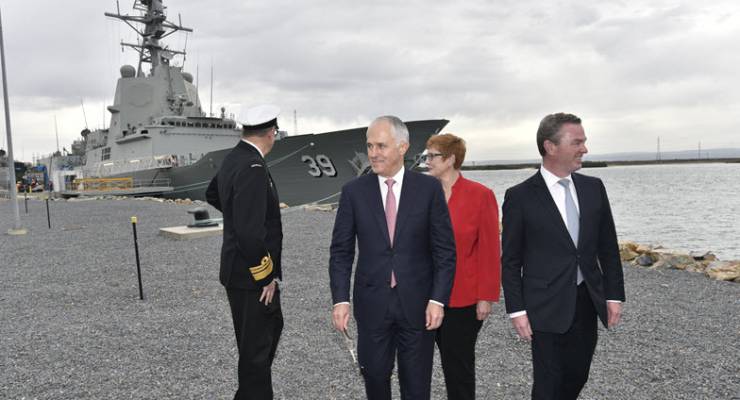
As the collective anger and disappointment gathers strength across the country over Malcolm Turnbull’s signature infrastructure policy the National Broadband Network-Lite, an even costlier policy is taking shape in the form of the National Shipbuilding Plan (NSP).
The bold project that will, in the words of senior naval officers at the Submarine Institute of Australia’s recent annual conference in Adelaide, “allow Australia (as an island nation) to take its rightful place” as a shipbuilding nation. The scope for cost blowout, delays and poor scoping and technology divisions such a massive and highly complex undertaking are almost endless but the rewards for success are also substantial and potentially nation-changing.
The initial headline figure on the NSP is $90 billion — but that’s really only the tip of the iceberg with an air warfare destroyer (or guided-missile destroyer) project to build three ships entering its final stage, and the launch of the HMAS Hobart in September — already budgeted at $9 billion. The other two ships, the Brisbane and the Sydney, are already in progress and due to be delivered in April 2018 and December 2019, and the long-term maintenance costs on at least three Collins-class submarines that will undergo a major upgrade to extend their lives by 10 years each. Twelve submarines and 33 frigates are planned under the NSP.
One way or another it will be a central plank in Malcolm Turnbull’s legacy after he switched tack from Tony Abbott’s plan to buy relatively cheap off the shelf submarines from Japan, making a 30-year commitment to develop a sustainable, technology-heavy industry sector in Australia by building the ships in SA.
The the decision to build the submarines and frigates in Australia is a clear attempt to finally replace the loss-making auto industry and fits with Turnbull’s stuttering National Innovation and Science Agenda and, if played right, could well salvage a big win for that strategy by using $1.6 billion that has been set aside for the Next Generation Technologies Fund, the Defence Innovation Hub and a clutch of smaller initiatives.
The rapidly rising concerns over exactly what the NBN will actually deliver to most Australians are a stark warning of how well-intentioned and expensive (but ill-conceived possibly fatally designed) “nation building” projects can go awry through rushed decision making and politically driven changes.
The vested interests here are legion so unsurprisingly rumours are already rife in the defence force, the defence and industry departments responsible for delivering on the project, as well the sprawling defence industry supply chain, about trouble with the submarine contract which was handed to France’s Naval Group.
One big and potentially project-crimping issue has already emerged: the lack of people to work on the project at multiple levels. Naval Group has found that attaining enough skilled people for just the design stage is proving difficult.
Sources familiar with the Future Frigates program told Crikey that the navy was “building ships they wont have enough sailors for”. And indeed, there is cap on numbers for all parts of the armed forces at present.
There are also signs that the broader implications of such a major project have not been considered across other portfolios, and certainly no whole- or part-of-government approach to the project, or the complex national implications, has been elucidated.
The sheer numbers that are being sought will add tens of thousand of people to the defence industry in and out of uniform — particularly if the dark warnings of the conservative think tank the Australian Strategic Policy Institute in its November 16 report, in which it calls for even more spending, are heeded. This augurs the possibility of a deeper and longer lasting cultural shift as Australian defence, with its inherent nationalism, becomes an even more significant industry. ASPI want the government to further step up defence spending beyond the 2% of GDP target that is in the current plans.
The resources sector’s two biggest exports, iron ore and coal, are highly unlikely to return to boom times any time soon, so there will be a huge temptation to create more defence construction jobs. Yet these new priorities of government spending are already bumping up against other imperatives: health as the population ages, much needed tourism infrastructure (including big ticket improvements to urban public transport and regional rail), and education as the digital revolution continues to roll across the economy.
Providing that too much money is not pissed into the wind — the Air Warfare Destroyer project is already more than 10% over budget — the ramp-up in defence spending is a on face value a big win for Australia’s economy. But it must be considered within the bigger picture at many levels and is now a major policy priority for this and future government.








Turnbull’s plan for ship building illustrates the dire state of Australia’s manufacturing industry. The fact that technicians and skilled personnel cannot be found is no surprise at all. Successive governments have gone from a manufacturing base to a service industry base-heavy industry is virtually finished. No car manufacturing, no ship building, no rail industry.
Even if naval vessels are built here, it would make far greater sense to buy off-the-shelf designs and assemble them here-the potential for disaster with in-house design, cost over runs and constant delays into service might be mouth-watering for the contractors involved, but on pastform, the taxpayer will get a poor deal. It all seems to me a Turnbull thought bubble for the moment.
J Gleeson
Technical, note.
Pissing into wind , or ,nautically, pissing to windward – means that you are going to get your own back.
If there is war in the Pacific, how will Australia survive without a broadly based military support industry and sufficient oil refineries? On the current system we would be out of petroleum fuels in 2 weeks.
After the way this and other LNP State governments have wound back VET and stripped TAFEs almost buck naked, turning out half-educated Tradies, it is no surprise that there is a shortage of the necessarily skilled personnel eligible for security clearance. This is one instance where 457 visa holders can’t fill the gaps!
It is obvious that the next Labor government will need to drastically increase TAFE funding, and ramp up the supply of tradies. 457 visas should not even be considered…for security or any other reason…when we have so many young people unemployed.
Pity the Coalition doesn’t pull its finger out and start the process NOW.
Don’t hold your breath on that happening…they haven’t got a bloody clue, as usual!!
” . . . what could possibly go wrong?”
Australia needs, must, mobilize its technological potential, know-how, given national, regional responsibilities, and present, future geopolitical challenges. For as Michael says “. . . but the rewards for success are also substantial and potentially nation-changing.”
Australia has grown-up under protective umbrellas’ that may not necessarily be available to us, perhaps should not be available for us; in the future? No matter what might be the PM’s motivation in committing the nation to this high risk initiative; Australia may well need to be challenged, and if in so doing we incur a few blood noses gaining essential experience . . . so be it! ” . . . what could possibly go wrong?” Simple, if we fail to identify the essential key executive staff; hold them ruthlessly, fully accountable and, back them up when the inevitable happens . . . .